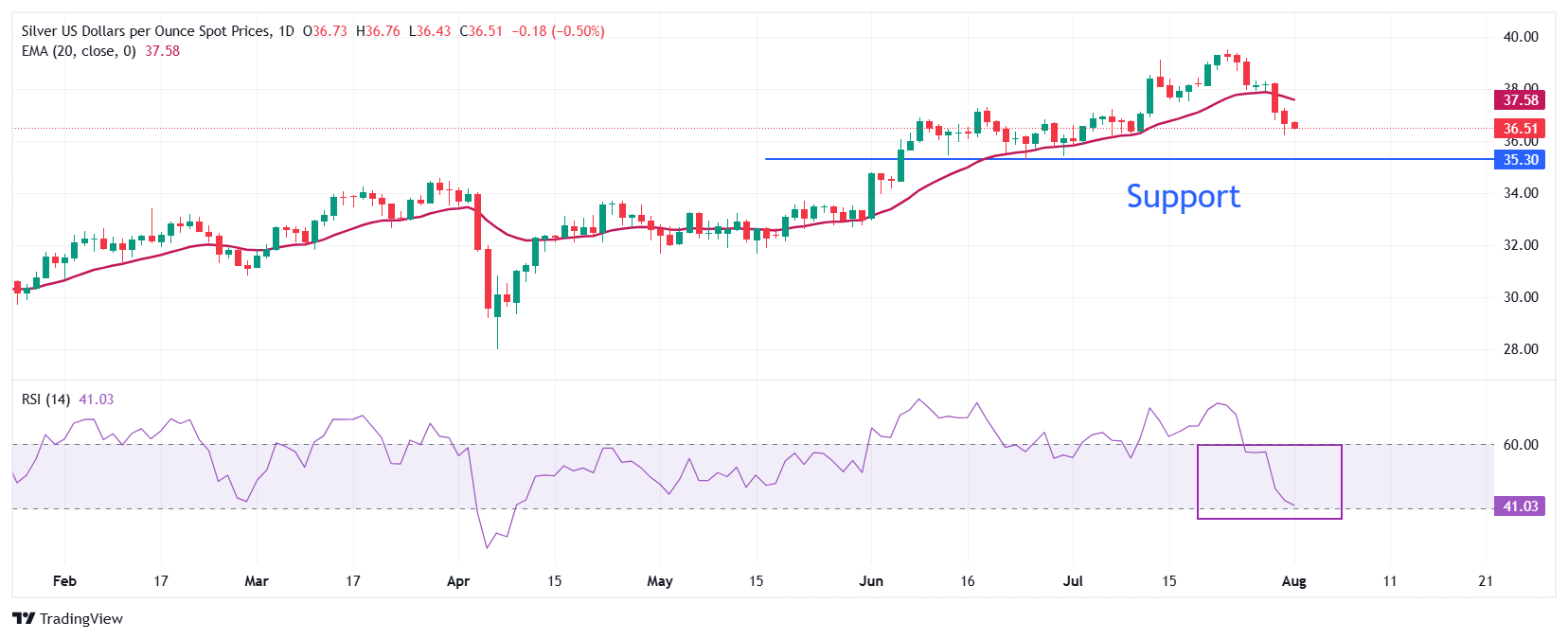- Silver price weakens as global trade uncertainty diminishes, following trades deals by the US with its key trading partners.
- Traders pare bets supporting interest rate cuts by the Fed in the September meeting.
- The US economy is expected to have added fresh 110K workers in July.
Silver price is down 0.5% to near $36.50 during the European trading session on Friday. The white metal faces selling pressure as the confirmation of tariff deals by the United States (US) with a number of its key trading partners, such as Japan, the European Union (EU), South Korea and others and increasing investors’ confidence that Washington will reach an agreement with China have diminished demand for safe-haven assets, such as Silver.
Safe-haven assets performed strongly since the announcement of the tariff policy by US President Donald Trump, which aimed to reduce wide fiscal deficit of the nation. The demand for these assets increased as investors became worried that the protectionist policy could lead to a damaging global trade war.
Theoretically, heightened global economic tensions improve demand for safe-haven assets.
Meanwhile, a strong rally by the US Dollar (USD) has also weighed on the Silver price. The US Dollar Index (DXY), which tracks the Greenback’s value against six major currencies, trades firmly near a fresh two-month high around 100.00.
Technically, higher US Dollar makes the Silver price an expensive bet for investors.
The US Dollar has strengthened as traders pare bets supporting interest rate cuts by the Federal Reserve (Fed) in the September meeting due to upbeat Q2 Gross Domestic Product (GDP), hot Personal Consumption Expenditure inflation (PCE) report for June, and signals from Chairman Jerome Powell that there is no rush for interest rate cuts.
Higher interest rates by the Fed bode poorly for non-yielding assets, such as Silver.
In Friday’s session, investors will focus on the US Nonfarm Payrolls (NFP) data for July, which will be published at 12:30 GMT.
Silver technical analysis
Silver price trades lower around $36.20, the lowest level seen in almost two weeks. The near-term trend of the white metal is bearish as it trades below the 20-day Exponential Moving Average (EMA) around $37.60.
The 14-day Relative Strength Index (RSI) slides to near 40.00. A fresh bearish momentum would emerge if the RSI breaks below that level.
Looking down, the June 24 low of $35.28 will act as key support for the major. On the upside, the June 30 high near $38.25 will be a critical hurdle for the pair.
Silver daily chart

Silver FAQs
Silver is a precious metal highly traded among investors. It has been historically used as a store of value and a medium of exchange. Although less popular than Gold, traders may turn to Silver to diversify their investment portfolio, for its intrinsic value or as a potential hedge during high-inflation periods. Investors can buy physical Silver, in coins or in bars, or trade it through vehicles such as Exchange Traded Funds, which track its price on international markets.
Silver prices can move due to a wide range of factors. Geopolitical instability or fears of a deep recession can make Silver price escalate due to its safe-haven status, although to a lesser extent than Gold’s. As a yieldless asset, Silver tends to rise with lower interest rates. Its moves also depend on how the US Dollar (USD) behaves as the asset is priced in dollars (XAG/USD). A strong Dollar tends to keep the price of Silver at bay, whereas a weaker Dollar is likely to propel prices up. Other factors such as investment demand, mining supply – Silver is much more abundant than Gold – and recycling rates can also affect prices.
Silver is widely used in industry, particularly in sectors such as electronics or solar energy, as it has one of the highest electric conductivity of all metals – more than Copper and Gold. A surge in demand can increase prices, while a decline tends to lower them. Dynamics in the US, Chinese and Indian economies can also contribute to price swings: for the US and particularly China, their big industrial sectors use Silver in various processes; in India, consumers’ demand for the precious metal for jewellery also plays a key role in setting prices.
Silver prices tend to follow Gold’s moves. When Gold prices rise, Silver typically follows suit, as their status as safe-haven assets is similar. The Gold/Silver ratio, which shows the number of ounces of Silver needed to equal the value of one ounce of Gold, may help to determine the relative valuation between both metals. Some investors may consider a high ratio as an indicator that Silver is undervalued, or Gold is overvalued. On the contrary, a low ratio might suggest that Gold is undervalued relative to Silver.

